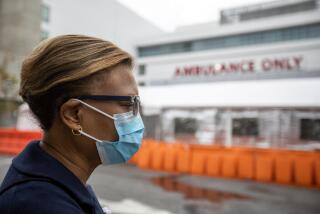Report Predicts County Trauma Care Problems
- Share via
A new report by trauma physicians at Los Angeles County-USC Medical Center questions the county’s ability to “maintain well-run trauma centers while caring for large numbers of uninsured patients.”
The report, published today in the Journal of the American Medical Assn., puts the financially strapped local public medical system in the national spotlight, warning that the health care crisis in Los Angeles County “is a large-scale example of what may soon occur in many American cities.”
“It should serve as a clarion call to communities across the country that a similar consequence could befall them if they do not take heed from the Los Angeles County experience,” Dennis Andrulis, an analyst at the National Public Health and Hospital Institute, said in an editorial in the AMA journal.
The county health crisis, brought on by a $655-million health services budget shortfall that threatened to close County-USC last year, led to a $364-million federal bailout. But restructuring the system as planned may only increase pressure on trauma services, the physicians say.
That is because as inpatient hospital beds are cut in favor of decentralized outpatient services, the overall proportion of County-USC’s patients receiving trauma care will go up, said Dr. Edward Cornwell III, the report’s lead author. “More and more of the patients will be of the type that use up more resources,” he said.
“That’s conceivable,” said Jonathan Freedman, director of the county’s Medicaid demonstration project, which is involved in the restructuring. He said cost pressures may result in some private emergency rooms shutting down, further burdening public hospitals such as County-USC. But it’s “hard to predict trauma cases in the future,” he said.
Still, the trend is fairly clear. There are only 11 privately operated trauma centers in the county today, down from 20 in 1983, said Dr. Robert Tranquada of USC’s School of Public Administration.
Trauma services especially feel the squeeze because they are the most expensive medical treatment available and are legally required to accept all patients, regardless of ability to pay. About 40% of trauma care delivered at county public hospitals is not paid for by patients or insurance companies, Tranquada said.
Among the nation’s three busiest trauma centers, County-USC treated 6,900 trauma victims last year, with 52% of major injuries involving blunt trauma, such as a car crash, and 48% involving penetrating trauma, such as gunshot or knife wounds, the physicians said.
The new report says County-USC trauma physicians have been trying to cut costs by avoiding unnecessary diagnostic tests and surgery. In a new study of firearm victims taken to the medical center, only 188 of 309 who were shot in the gut needed emergency abdominal surgery, while the rest managed with other, less costly treatments. Typically, upward of 90% of such patients would have been operated on, Cornwell said.
A potential source of health department revenue, the physicians suggest, might be a tax on alcohol served in bars and restaurants, which appears to contribute to violence and accidents.
Though such a proposal has been rejected by the state Legislature, the physicians believe that it makes sense, because their recent study of 518 trauma victims found that 52% were found to have alcohol in their blood.
More to Read
Sign up for Essential California
The most important California stories and recommendations in your inbox every morning.
You may occasionally receive promotional content from the Los Angeles Times.












